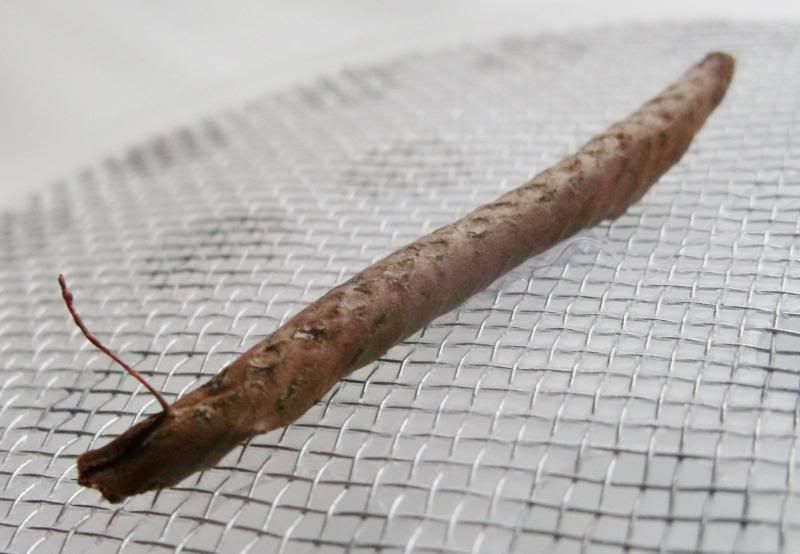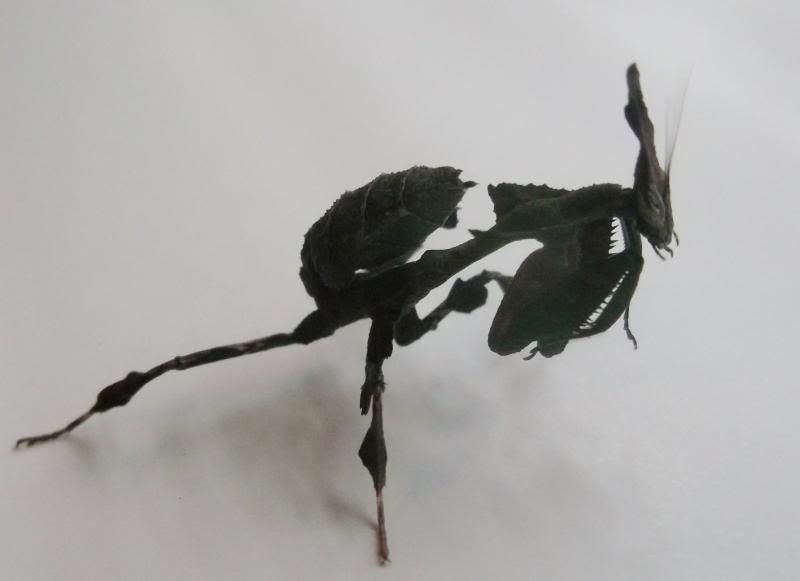Phyllocrania paradoxa (Ghost Mantis)
Introduction:The world famous ghost mantis, an extremely popular and easy species to rear, is talked about on an hourly basis on the forums. Ghost mantises are a decent size, extremely hardy, long lived, and tolerant of almost any conditions, not to mention they come in a range of colors, from all shades of brown to yellow, black, gray, greens and even mixes. Ghost mantises are very easy to rear and very attractive.(agent A)
The genus name means "leaf head", and the head is outfitted with a twisted, leaf-like projection on top. The walking legs also have smaller, leaf-like lobes and the abdomen has a pair of flat, ragged extensions on each side. This may be the only species that's magnificent and always commands interest but is also easy (other mantids tend to be either uniquely amazing to look at or easy to keep).(Orin)
Native range: Africa.
Difficulty level: beginner.
Development:
Ghost mantises are slow growers at any temperature, though the time it takes from L1-L4 is relatively normal, L5 to adulthood is a long waiting game.(agent A)
I must say right off the bat that males and females molt the SAME number of times. Don't let anyone tell you the females have an extra molt; they DONT! They BOTH molt SEVEN times.(agent A)
The molt from L1 to L2 takes only about two weeks, and L2 to L3 is just a few days longer. L3 to L4 is less than 3 weeks, but then L4 to L5 takes up to a month. L5 to L6 is at least five weeks. L6 to L7 (sub adult for BOTH instars) is a bit longer, and they can spend 2-3 months in the sub adult stage, and surprisingly males can take longer than females to reach adulthood.
(agent A)
This mantis grows slowly, and lives longer than most species. As newly hatched nymphs, and for the first few molts, they eat and grow normally. However, as each successive molt occurs the interval between molts gets longer and longer, with the stage prior to the final molt taking up to two months. Limited food or care could easily stretch development far past a year, but five months is normal with adequate care.(Orin)
Behavior/temperament:
- Degree of activity
- Degree of aggression or timidity
- Propensity to cannibalize
- Dynamics of threat display
This species can tolerate temperatures between 65 and 85 degrees and can accept a wide range of humidity: from as low as 40% to as high as 70%. You can keep huge groups in terrariums or net cages with real or fake plants with little fear of cannibalism, or you can keep them in deli cups with a fake leaf and a paper towel on the bottom, or anything in between. So long as they can grip, climb, and walk, they are good.(agent A)
Once they have molted a few times, they do not need much water or humidity, and only require a light misting two to three times a week. Phyllocrania paradoxa seldom kill each other after the third molt. They are often kept together long-term but females do eat males.(Orin)
Feeding
Nymphs can be tricky to feed, as they may not go after crawling food. L1 and L2 will eat hydei; L3 and L4 will eat houseflies (though L4 will also eat bottleflies), and after this, bottleflies are a good food for nymphs. They also appreciate moths, roaches, and crickets. Nymphs can go a long time without food, I've had nymphs (unintentionally) go 5 weeks without food and survive; though if a nymph hasn't eaten in a while, it is not advisable to just load it up with food (it wont be able to digest it all, possibly resulting in death). Instead, fill it back up slowly for 2 weeks before getting it real fat again (this goes for ANY animal btw).(agent A)
Ghost mantids prefer to eat food a quarter of their mass or less. They are hearty feeders but prefer to stay on a fixed perch which should be positioned so food comes nearby. They rarely chase after prey unless it is less than an inch away (glass climbing roach nymphs are a favorite food).(Orin)
Breeding
The males are easily identified after two molts because the expansion of the male's prothorax is much smaller and the leaf on the head is pinched in the middle. Both genders are about two inches long when fully grown but the female is much more massive. Her tegmina look like dried brown leaves complete with veins while the male's tegmina look more like the hindwings and give him an odd, rectangular shape.(Orin)
Sexing can be done as early as L4 by looking at the head crown. Males have a tall, jagged crown, while females have a forked and structured, symmetrical head crown. And as nymphs get older, males will have a narrower range of colors(mainly blacks and grays), while females take on browns and greens.(agent A)
Surprisingly, males can take longer than females to reach adulthood. Fortunately, they are quick to breed. These are an extremely prolific species. Both sexes can be ready to mate as early as 2 weeks into adulthood, but I wait 3 weeks to be safe.(agent A)
Males barely eat (don't be surprised if during his adult life, a male only eats one bottlefly) but are active and fly readily. Females eat a lot, and should be nice and well fed before mating. You don't usually have to worry about females attacking the males, especially if she is well fed. A good way to breed them is to have the males in a warm, humid cage (80oz cup with wet paper towel under a heat lamp works fine) and let them warm for two days or so; then in the evening put in a female or two, and usually you will wake up to a connected pair. They stay connected for 2-8 hours, and females will lay ooths frequently. Try not to keep females too warm after mating, since they have a habit of laying small ooths every few days rather than long ones every week and a half.(agent A)
Oothecae:
Giving them fake plants to lay on also helps increase ooth length. Ooths can be incubated at room temp with twice weekly misting. Hatching occurs 6-10 weeks later, with 20-60 nymphs resulting. Females can lay well over 12 ooths in their lifetime.(agent A)
They prefer to construct oothecae on sticks a quarter inch or less in diameter. Oothecae are similar in shape and size to Creobroter oothecae, but the surface is smooth and glossy and there is a long thread-like extension at one end.(Orin)
Optional
- Health Issues: infections or illnesses encountered.
- Additional Observations: pertinent information which doesn't neatly fit anywhere else.
- Photos: up to five may be posted at the bottom of the completed template. Please limit these photos to no more than one of an ootheca, two of nymphs(different instars), one of an adult female, and one of an adult male.

(photo: jamurfjr)

(photo: jamurfjr)
Contributors: Agent A, jamurfjr, Orin
Last edited by a moderator:



